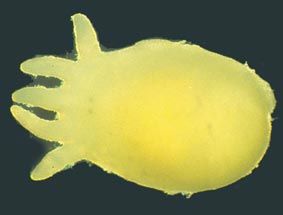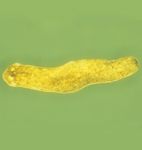| Flat worms are often known by their class name, Turbellaria. |
| Descriptive Features: body flat, thin or squat, bilaterally symmetrical
absence of a coelom, anus, no distinct internal systems
spaces between internal organs occupied by connective tissue
Temnocephalidea with 2 – 6 tentacles posteriorly, suction disc anteriorly
Total length: up to 20 mm |

|
|
| |
| Taxonomic Checklist: SubOrder
Tricladida
Temnocephalida |

|
|
| |
Distribution: Australia wide
Sensitivity Rating: Turbellaria - SIGNAL grade 2, Temnocephalida - SIGNAL grade 5
Functional Feeding Group: predator, scraper
|

|
|
| Ecology: Flat worms occur in streams and lakes. Tricladia are free living and found on the underside of rocks and wood. Most Temnocephalida are ectocommensal on crayfish and larger prawns (Decapoda). Both groups are carnivores upon small invertebrates as well as grazers of microflora (bacteria and algae). Tricladia move by the action of cilia along a path of mucus. Some larger species utilise muscular ripples to swim in lentic waters. All flatworms are hermaphrodites. Tricladia can regenerate into two individuals, if cut in half. They can also reproduce sexually laying eggs in leathery cocoons. Cocoons are resistant to desiccation and predation. Temnocephalidea move by a looping motion. They also reproduce sexually laying eggs in leathery cocoons with stalks and attaching them to the exoskeleton of the host. Flatworm eggs hatch into small immature worms. |

|
Temnocephalida |
|

|
Tricladida |
|
|
| |
| Information Sources: Williams 1980, Gooderham & Tsyrlin 2002, Hawking & Smith 1997, ABRS 2009 |
More ››› key to orders 
|
|